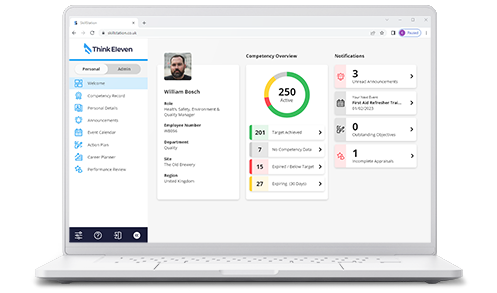Cyber Security Training Bundle eLearning Course
Overview
This cyber security training bundle consists of 10x online courses which are certified by the National Cyber Security Centre, NCSC.
90% of cyber attacks are caused by human error, and with global attacks increasing year on year, training your staff to embed safe practices and effective protection across your organisation, keep themselves safe and reduce risks, has never been more critical.
Course Modules
- Handling Data – the importance of data protection, explains the risks of transferring and storing unencrypted personal data and how to dispose of data once it’s no longer required.
- Malware Attack – what malware is, how cyber criminals use it to gain unauthorised access to personal information or systems, and how to spot and report it.
- Passwords and Authentication – how to create strong passwords, how password managers can be used and what multi-factor authentication is.
- Phishing – what phishing is, how cyber criminals use it to obtain personal data and how to spot then report it.
- Protecting Your Business from Cyber Attacks – explores specific risks, responsibilities and the processes required to enhance your organisational resilience to cyber attacks.
- Reporting Cyber Crime – what happens when you report a cyber crime, how to report it and who to report it to.
- Responding to a Cyber Crime – how to reduce the impact of cyber attacks and restore lost data.
- Safe Device Use – explores the possible risks when using devices and removable media and what measures you should take to protect sensitive information.
- Staying Safe Online – demonstrates how cyber criminals can exploit social media, the risks of unsecured networks and explains the steps you can take and things you can look out for to stay safe online.
- Whaling Attack – explains what a whaling attack is, how cyber criminals use it to gain access to personal data or systems, and how to spot and report it.
Objectives
After completing this course, I’ll be able to:
- Know how to encrypt and password protect an email attachment using mail services from Google, Apple and Microsoft,
- Identify the risks associated with transferring, storing and deleting unprotected personal data, and
- Explain what the Data Protection Act 2018 and EU GDPR states all individuals and organisations must do.
- Identify the techniques cybercriminals use to carry out malware attacks,
- Recognise the risks and impact of a malware attack,
- Spot the signs of malware attempts,
- Prevent a potential malware attack on your organisation, and
- Know what steps to take in the event of becoming a victim of a malware attack.
- Confidently use the NCSC’s three random words technique to create strong memorable passwords,
- Explain what a password manager is and know how and when to use one, and
- Explain what multi-factor authentication is and know how and when to use it.
- Describe what phishing is
- Identify the techniques cybercriminals use to phish for information,
- Identify the common signs of a phishing attack, and,
- How to internally and externally report phishing attacks.
- Recognise the importance of planning for a cyber attack,
- Apply critical steps to prepare your organisation for a cyber attack,
- Identify the risks associated with your supply chain,
- Manage supply chain cyber risks effectively, and
- Enhance organisational resilience against cyber attacks.
- Explain in their own words the importance and benefits of reporting cybercrimes, and
- Identify the most appropriate authority, team or organisation to report a cyber crime to.
- Take appropriate steps to mitigate damage and restore data following a cyber attack,
- Report incidents,
- Inform internal and external stakeholders,
- Review lessons learned from incidents, and
- Update organisational plan.
- Recognise the techniques cybercriminals use to gain unauthorised access to data and devices,
- Identify the risks of using personal devices and removable media to sensitive organisation data,
- Store, share and use information and storage devices securely, and
- Protect your devices from unauthorised access.
- Identify if a website uses HTTPS,
- Explain the risks of using public Wi-Fi networks and what to use instead, and
- Explain the importance of social media and online privacy settings and how/when to update/change them.
- Understand why executives and their assistants can become victims of whaling attacks,
- Identify the techniques cybercriminals use to carry out whaling attacks,
- Recognise the risks and impact of a whaling attack,
- Spot the signs of whaling attempts,
- Know the steps you can take to prevent a successful whaling attack on your organisation, and
- Know what immediate actions to take in the event of becoming a victim of a whaling attack.
This course has a minimum of 25 learner registrations for us to provide a quotation.
Request a Quotation- Language
- UK
- Date last updated
- 4/28/2023
- Duration
- 50 Minutes
- Suitable Devices
-
- PC
- Phone
- Tablet
- Audio is Required
-
- Yes
- Includes Video
-
- Yes
- Downloadable Resources
-
- No
- Completion Criteria
-
- Pass final test
- Visit all pages
- Pass Mark
-
- 80% pass mark required
- Course Technology
-
- HTML5
- SCORM 1.2
- Can be customised
-
- No
- Accreditation or Endorsements
-
- NCSC
- Languages
-
- English
- Multiple Languages available within Course
